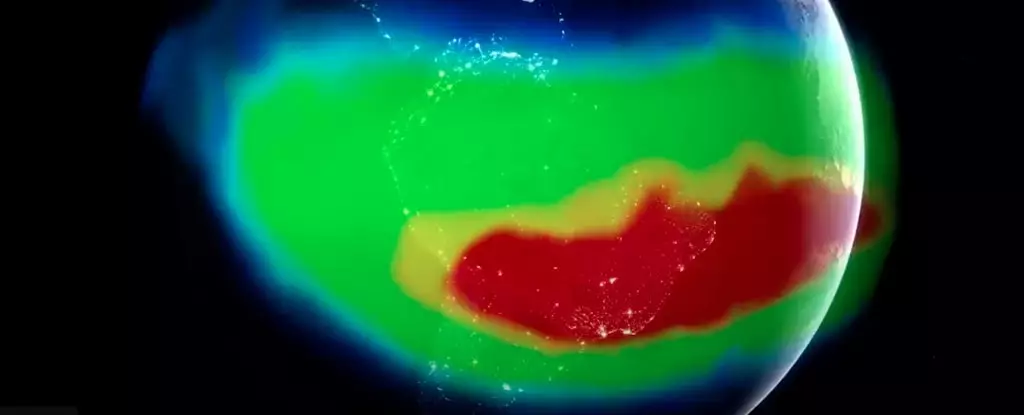Earth’s magnetic field has long been a subject of fascination for scientists, not only because it shields our planet from harmful solar radiation but also due to its complex and dynamic nature. Among the various phenomena tied to our magnetic field, the South Atlantic Anomaly (SAA) stands out as a significant region of interest. Spanning an area between South America and southwest Africa, this unique anomaly exhibits a pronounced dip in magnetic intensity that has raised eyebrows in the scientific community, particularly among researchers at NASA.
Research has shown that the SAA poses notable challenges for spacecraft, including satellites and the International Space Station, operating in low-Earth orbit. These instruments traverse the anomaly as they move around the planet, exposing themselves to charged particles that can disrupt onboard systems. Understanding the implications of this phenomenon is crucial for the safety and functionality of space missions, making it an essential subject of study.
The SAA can be visualized as a ‘dent’ or ‘pothole’ in the magnetic field, where the intensity of the magnetic forces is markedly less than in surrounding areas. While this anomaly does not negatively impact life on Earth, it can prove detrimental to technology in orbit. When spacecraft pass through the SAA, they are vulnerable to high-energy protons originating from the Sun, which can cause disruptions ranging from minor glitches to severe system failures.
This vulnerability has made it necessary for satellite operators to implement precautionary measures, such as temporarily shutting down certain systems during transit through the anomaly. These safety protocols are vital for maintaining the integrity of crucial mission data and preventing irreversible damage to sensitive equipment.
To fully grasp the nature of the South Atlantic Anomaly, one must delve into the geophysical processes that underpin it. At the heart of Earth’s magnetic field lies a swirling ocean of molten iron located in the outer core, which generates electrical currents and thus produces magnetic forces. However, this generation is not uniform; variations in the structure of the Earth’s interior can create anomalies like the SAA.
One notable feature influencing the magnetic field dynamics in this region is the African Large Low Shear Velocity Province, a massive geological formation located nearly 2,900 kilometers beneath the surface. Scientifically speaking, this dense rock reservoir interferes with the normal generation of magnetic fields, leading to the observed dip in intensity. Furthermore, the tilting of Earth’s magnetic axis might play a role in amplifying the anomaly.
Researchers, including NASA geophysicists, have highlighted that the SAA could also signify a localized field experiencing changes in polarity, which contributes to the already weak magnetic intensity in the area. These insights underscore the complexity and dynamism of the magnetic forces at play beneath our feet.
Recent studies have revealed that the SAA is not static; rather, it is in a state of flux, drifting around and potentially dividing into two separate cells of low magnetic intensity. NASA’s ongoing tracking efforts using CubeSats have provided key insights into this phenomenon. Historical data suggest that the SAA may not be a transient occurrence but rather a repeating event that has affected Earth intermittently over millions of years.
This raises profound questions about the long-term implications of the SAA. Experts posit that while its behavior is perplexing, the anomaly does not necessarily indicate an impending flip in Earth’s magnetic field—a complex process that unfolds over extensive geological timeframes.
With the SAA exhibiting signs of change, experts from NASA emphasize the necessity of ongoing observations and studies. Understanding this magnetic anomaly not only serves to protect space exploration efforts but also provides a unique platform for unraveling mysteries about Earth’s internal dynamics. As researchers like Terry Sabaka suggest, continued monitoring will allow scientists to capture the intricate changes in the SAA’s morphology and gain deeper insights into its nature.
As we advance into an era of increased reliance on space technology, keeping a watchful eye on phenomena like the South Atlantic Anomaly becomes ever more critical. It brings with it a wealth of questions waiting to be answered and highlights the remarkable complexity of the world we inhabit, both above and below the surface. The pursuit of knowledge in this realm is a testament to the ongoing human effort to understand our planet and its myriad mysteries.


Leave a Reply